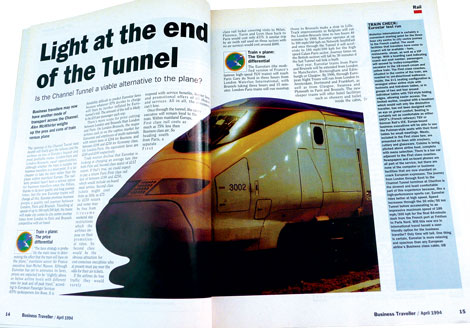Alex McWhirter looks through the Business Traveller archive. This month: Eurostar, April 1994
Is the Channel Tunnel a viable alternative to the plane? That was the question we posed in April 1994, and the subsequent years have provided the answer – a resounding “yes”.
Before Eurostar appeared on the scene in November that year, surface travel between London, Paris and Brussels was not used by business people at all. It involved awkward transfers by train and ferry, taking eight hours or more for what should have been a short trip.
Eurostar transformed the travel experience. The journey time was cut to about three hours, and it became the preferred option for going between these three capital cities.

Eurostar quickly grabbed market share from the airlines. Passenger numbers were further boosted when the UK’s HS1 opened. When Eurostar moved from London Waterloo to St Pancras, journey times were reduced to two hours 16 minutes for Paris and two hours one minute for Brussels. Eurostar claims a market share of almost 80 per cent for both routes and the airlines have scaled back their services.
But not everything has gone according to plan. In particular, UK regional travellers were never given the through services they were originally promised. A special fleet of 14-coach trains (normal Eurostars have 18) was constructed with the aim of running to Paris and Brussels from Birmingham, Manchester and Edinburgh or Glasgow with en route stops. A purpose-built depot was built outside Manchester.
An even more exciting plan was drawn up to operate through sleeper trains. These Nightstar services would have complemented the high-speed daytime trains. The plan was to run overnight from both London and the regions by 1996. The London trains would have run to Amsterdam, Cologne, Dortmund and Frankfurt, while from Glasgow, Swansea and Plymouth, there would have been Nightstar trains to Paris and Brussels. Luxurious “hotel-style” rolling stock was constructed with showers and toilets inside the cabins.
Sadly, neither project came to fruition. When the plans were drawn up, low-cost airlines didn’t exist. But by the mid-1990s, falling air fares and the growth in regional air service to mainland Europe rendered direct rail services commercially unviable. The regional Eurostars were relegated to SNCF domestic service (SNCF is Eurostar’s main owner), while the Nightstars were sold off to Canada’s Via Rail for its Renaissance trains.
Although Eurostar is the market leader from London, its passenger carryings have fallen far short of predictions. Early forecasts did not consider the regional cities opened up by the low-cost airlines. In 1996 it was predicted that Eurostar would accommodate 21.4 million passengers by 2004 but, in reality, only 7.3 million were carried.
Even today’s passenger numbers are well down. Last year, they fell just short of ten million despite the spin-off from the Olympics. A 2006 Department for Transport projection indicates carryings will not reach 16 million until 2037.
What about prices? In 1994, I wrote that return standard class tickets ranged between £75 and £150, with first class between £180 and £250. Now you pay between £69 and £309 for standard and £189-£490 for first. Today’s pricing is more complex, but Eurostar remains affordable provided you meet the booking restrictions.








